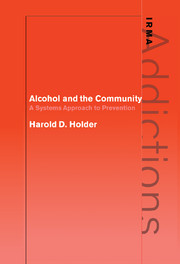Book contents
- Frontmatter
- Contents
- Series editor's preface
- Acknowledgements
- 1 The community system of alcohol use and alcohol problems
- 2 Consumption System
- 3 Retail Sales Subsystem: alcohol availability and promotion
- 4 Formal Regulation and Control Subsystem: rules, administration, and enforcement
- 5 Social Norms Subsystem: community values and social influences that affect drinking
- 6 Legal Sanctions Subsystem: prohibited uses of alcohol
- 7 Social, Economic, and Health Consequences Subsystem:community identification of and responses to alcohol problems
- 8 Community-level alcohol problem prevention
- References
- Index
1 - The community system of alcohol use and alcohol problems
Published online by Cambridge University Press: 22 September 2009
- Frontmatter
- Contents
- Series editor's preface
- Acknowledgements
- 1 The community system of alcohol use and alcohol problems
- 2 Consumption System
- 3 Retail Sales Subsystem: alcohol availability and promotion
- 4 Formal Regulation and Control Subsystem: rules, administration, and enforcement
- 5 Social Norms Subsystem: community values and social influences that affect drinking
- 6 Legal Sanctions Subsystem: prohibited uses of alcohol
- 7 Social, Economic, and Health Consequences Subsystem:community identification of and responses to alcohol problems
- 8 Community-level alcohol problem prevention
- References
- Index
Summary
Introduction
Joseph Townsend lives in Great Britain in the large metropolitan area of Birmingham. Concerned about the number of street people in his downtown neighborhood who were regularly intoxicated, Joseph organized his neighbors and many local shops to set up a storefront recovery center where alcohol-dependent people could get counseling and where meetings of self-help groups, e.g., Alcoholics Anonymous, could be held. The storefront recovery center was a big success, with many clients coming and going every day. After the center had been operating successfully for six months, Joseph noticed, during his regular walks through his neighborhood, that the number of people intoxicated on the street had not decreased. In fact, there appeared to be many more now than before. “ How could this be,” he wondered, “ after all the work we have done?”
In another community, Silver City, a small multi-ethnic town in New Mexico (USA), Mary and Charles Lopez, parents of two children, 15 and 18 years old, were concerned about the amount of drinking by local young people. They were fearful that their daughter and son might drink, and they were concerned about the risk of harm to their children and others in their community as a result of teenage drinking. Other parents joined them in assisting the local schools to adopt a health curriculum that informed young people about the risks of alcohol and other drugs. The school curriculum was widely and effectively implemented, and was popularly received by the community.
- Type
- Chapter
- Information
- Alcohol and the CommunityA Systems Approach to Prevention, pp. 1 - 28Publisher: Cambridge University PressPrint publication year: 1998



